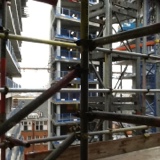Title Page
-
This form assumes that the job cannot be completed by a DTH or DAT engineer. A form must be completed for each SAT Job before it is undertaken. SAT jobs require two persons on site at all time otherwise they must be postponed. Modern apprentices may not take part in SAT work.
-
Job number
-
Job type
-
Please enter the date
-
Customers name
-
Site address
-
Engineer 1
-
Engineer 2
-
Is the job a true SAT job?
-
If not SAT is it
-
Please state why the job is DTH / DAT / IMPOSSIBLE
Risk Assessment
-
The following information constitutes an on-site risk assessment for the job. A method statement is also required
-
Access to height will be by
-
Please specify minimum control measures required
-
MINIMUM CONTROL METHODS
Sky SAT Processes as trained with rope access techniques in use -
Is there to be any additions or variations from standard control measures - please specify clearly
-
Please specify
-
MINIMUM CONTROL METHODS
Sky's fall arrest systems, eye bolting, ML and LM or equivalent from the ladder hierarchy -
Is there to be any additions or variations from standard control measures?
-
please specify clearly
-
What type of ladder will used?
-
8 rung ladder
-
PPE, Microlite + eyebolt if necessary to ensure security
-
Single section
-
PPE, Microlite, Laddermate, full fall arrest + EYEBOLT
-
Double section
-
PPE, Microlite, Laddermate, full fall arrest + EYEBOLT
-
Triple section
-
PPE, Microlite, Laddermate, full fall arrest + EYEBOLT
-
DAT roof ladder
-
PPE, 2 Microlite, 2 Laddermate, 3x full fall arrest + EYEBOLTS
-
Extended DAT roof ladder
-
As per DAT ladder procedure
-
combi ladder
-
PPE, other equipment and fall arrest as necessary. EYEBOLT at all times
-
Can a ladder mate be used?
-
Please state what alternative is to be used
-
Can a Microlite be used?
-
Please state what alternative is to be used
risk assessment part 2
-
If anchor points are needed for roped access are they
-
Existing and fixed (In date and permission grants to use)
-
Temporary Eg 20mm eyebolt, primary and back up
-
Part of building structure Checked and verified by both engineers
ON SITE IDENTIFIED HAZARDS
-
Adverse weather
-
Can the hazard be removed?
-
Can the hazard be controlled/minimised?
-
PLEASE ESCALATE AND PROVIDE DETAILS
-
Explain how?
-
Third Parties
-
Can the hazard be removed?
-
Can the hazard be controlled/minimised?
-
PLEASE ESCALATE AND PROVIDE DETAILS
-
Explain how?
-
Traffic
-
Can the hazard be removed?
-
Can the hazard be controlled/minimised?
-
PLEASE ESCALATE AND PROVIDE DETAILS
-
Explain how?
-
Existing equipment
-
Can the hazard be removed?
-
Can the hazard be controlled/minimised?
-
PLEASE ESCALATE AND PROVIDE DETAILS
-
Explain how?
-
Garden hazards
-
Can the hazard be removed?
-
Can the hazard be controlled/minimised?
-
PLEASE ESCALATE AND PROVIDE DETAILS
-
Explain how?
-
Ground Hazards
-
Can the hazard be removed?
-
Can the hazard be controlled/minimised?
-
PLEASE ESCALATE AND PROVIDE DETAILS
-
Explain how?
-
Any other hazards
-
State the hazards
-
Can the hazard be removed?
-
Can the hazard be controlled/minimised?
-
PLEASE ESCALATE AND PROVIDE DETAILS
-
Explain how?
Method statment
-
METHOD STATEMENT
a clear and detailed method for carrying Out the work must be recorded here before the work commences. Items to be included are site details, pre job preparation, type of job, roof type, roof angle, rescue consideration ( if standard state otherwise specify in detail. The method statement should have sufficient detail to allow another SAT team to understand how to would carry out the work.
Insert pictures or drawings -
Add drawing
-
Add media
-
Signed engineer 1
-
Signed engineer 2
-
Select date









